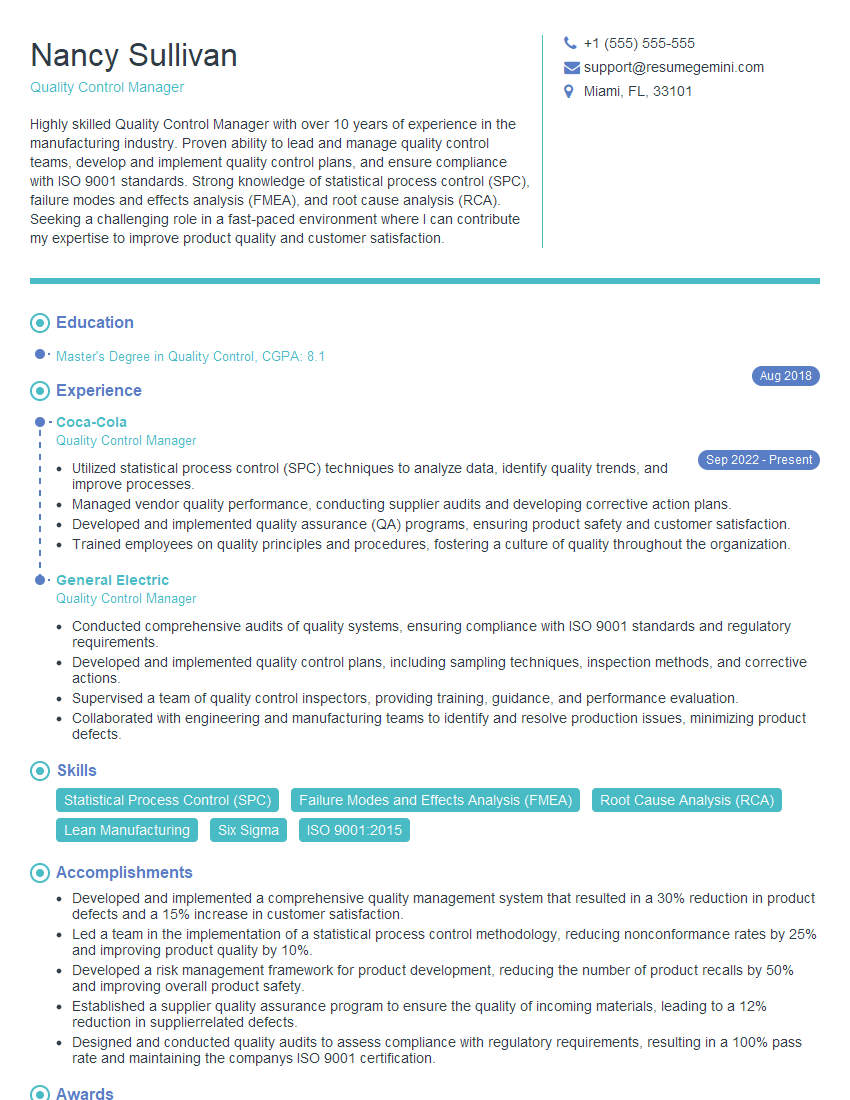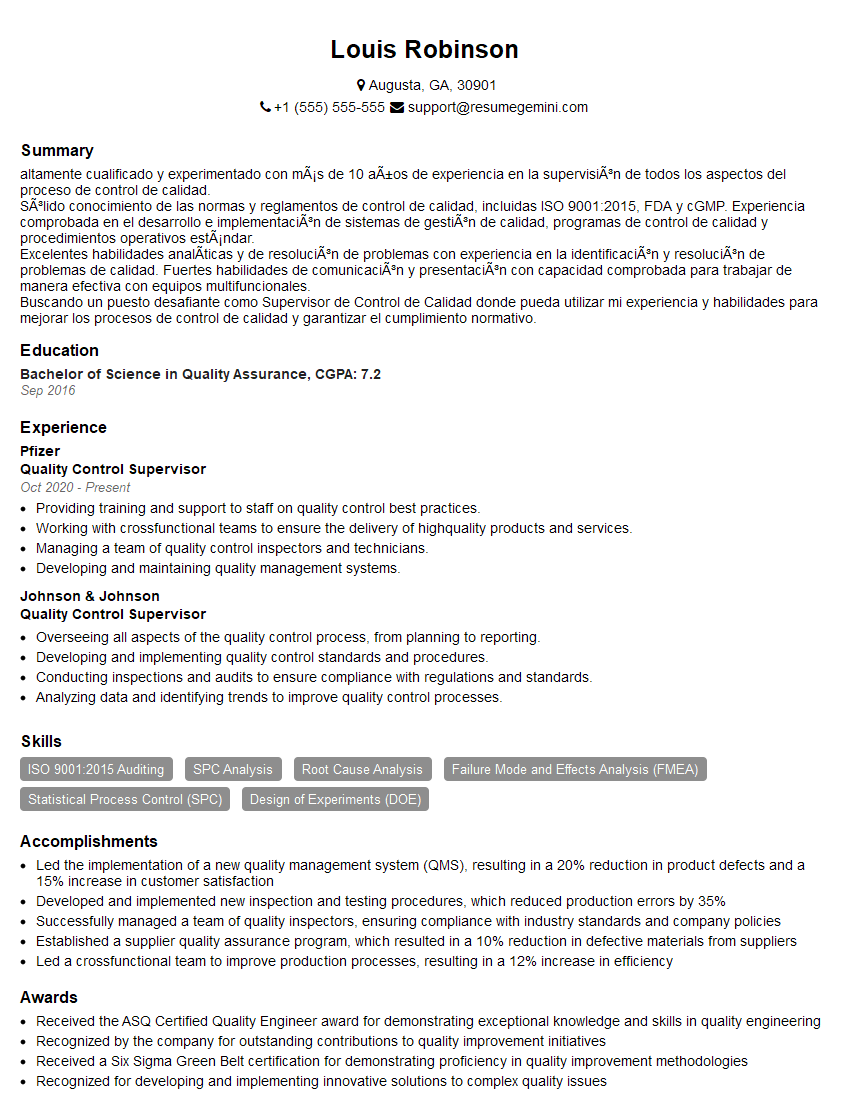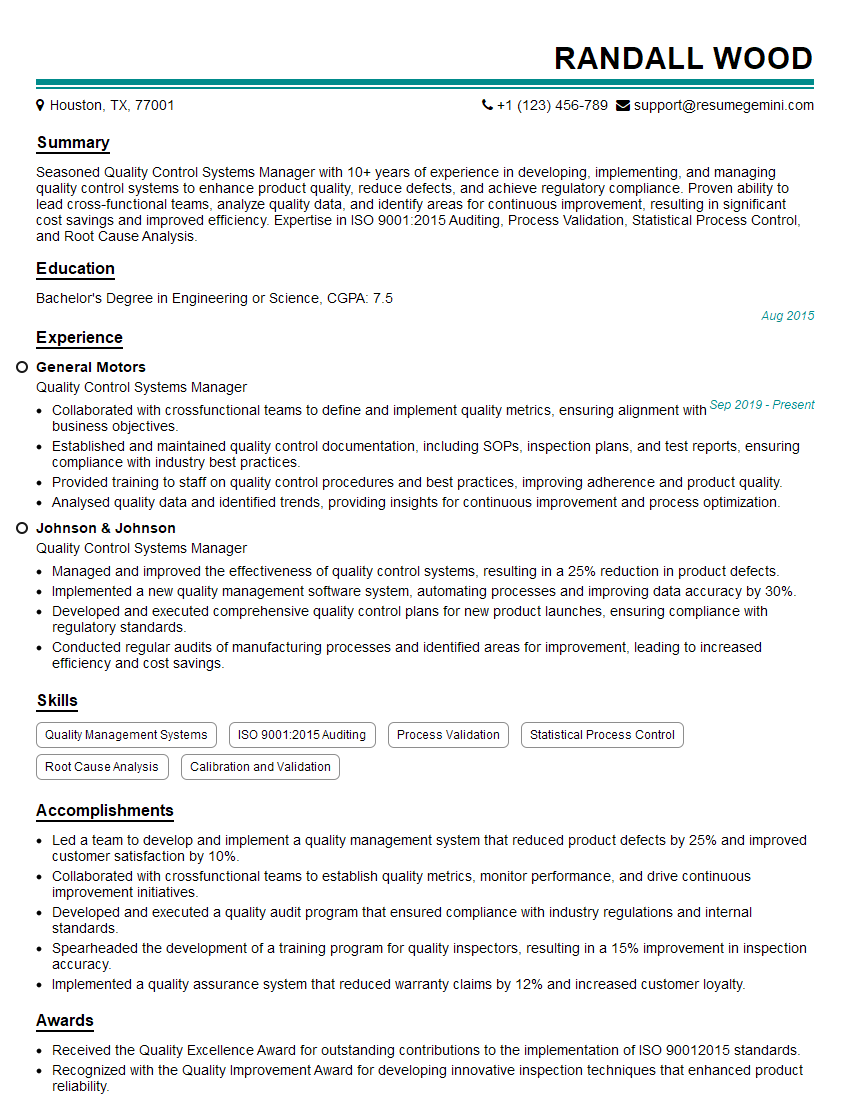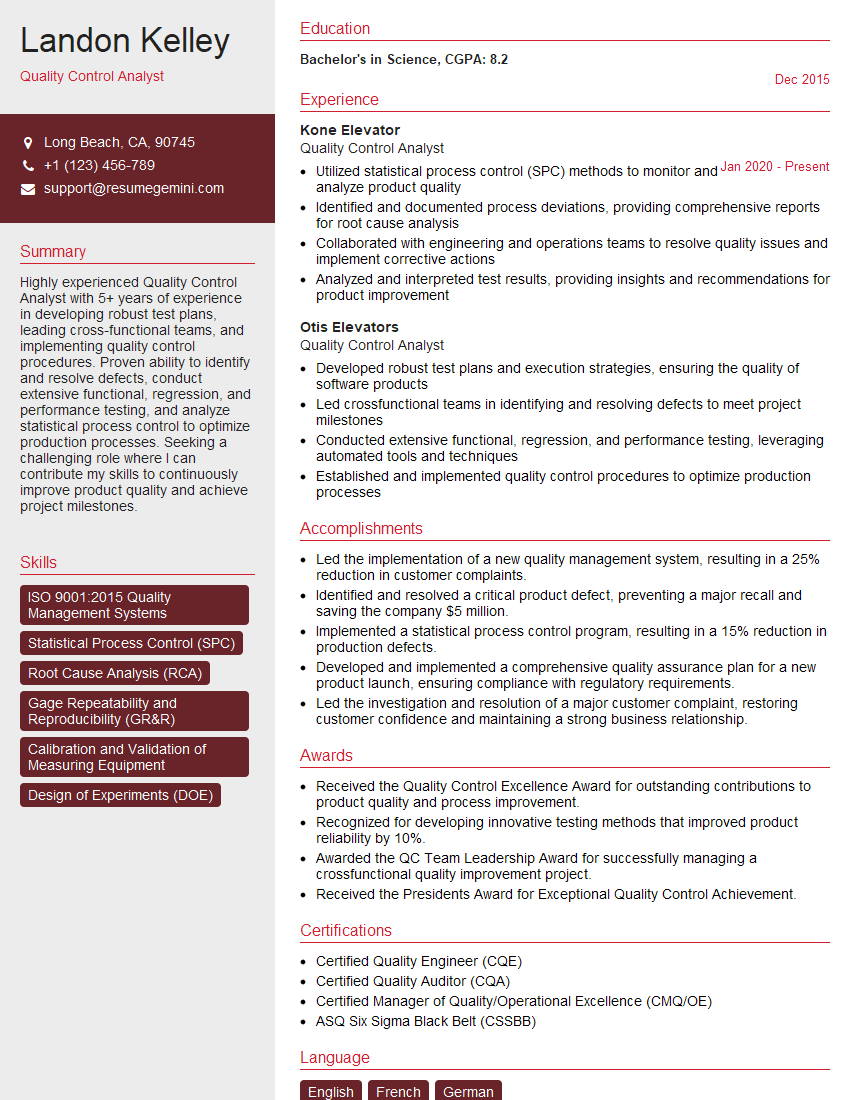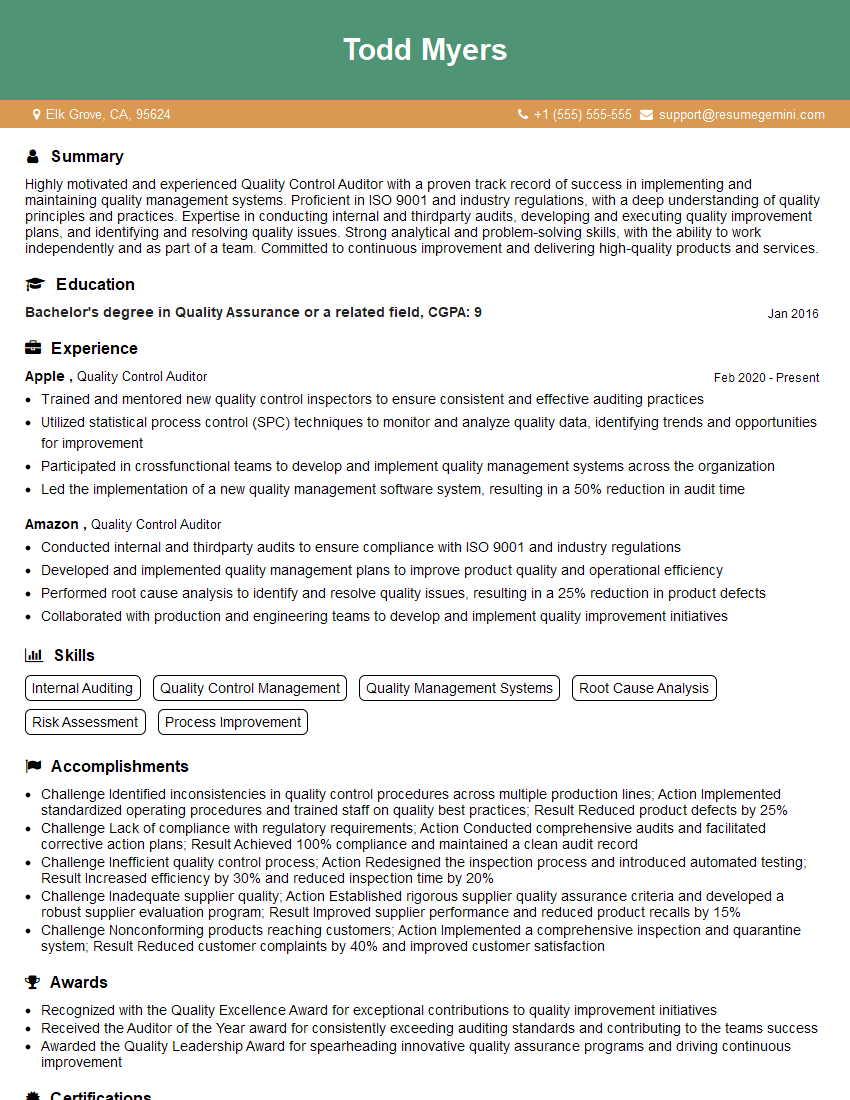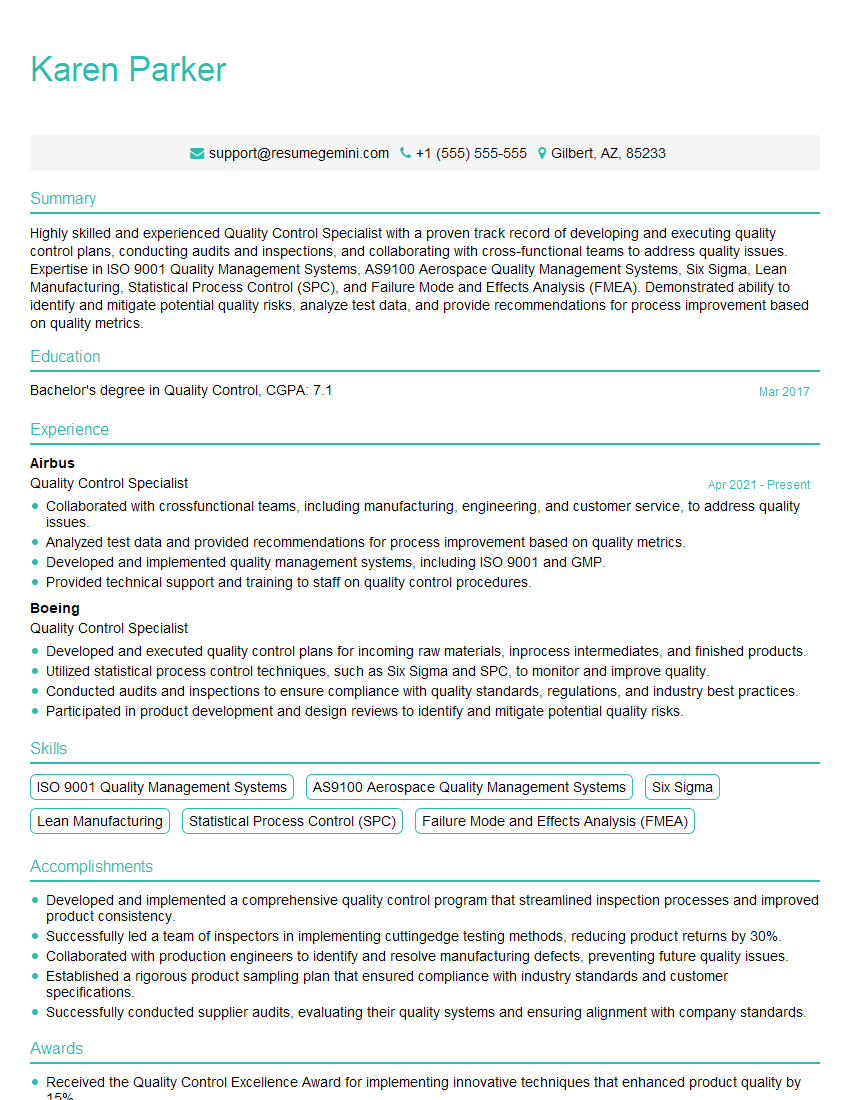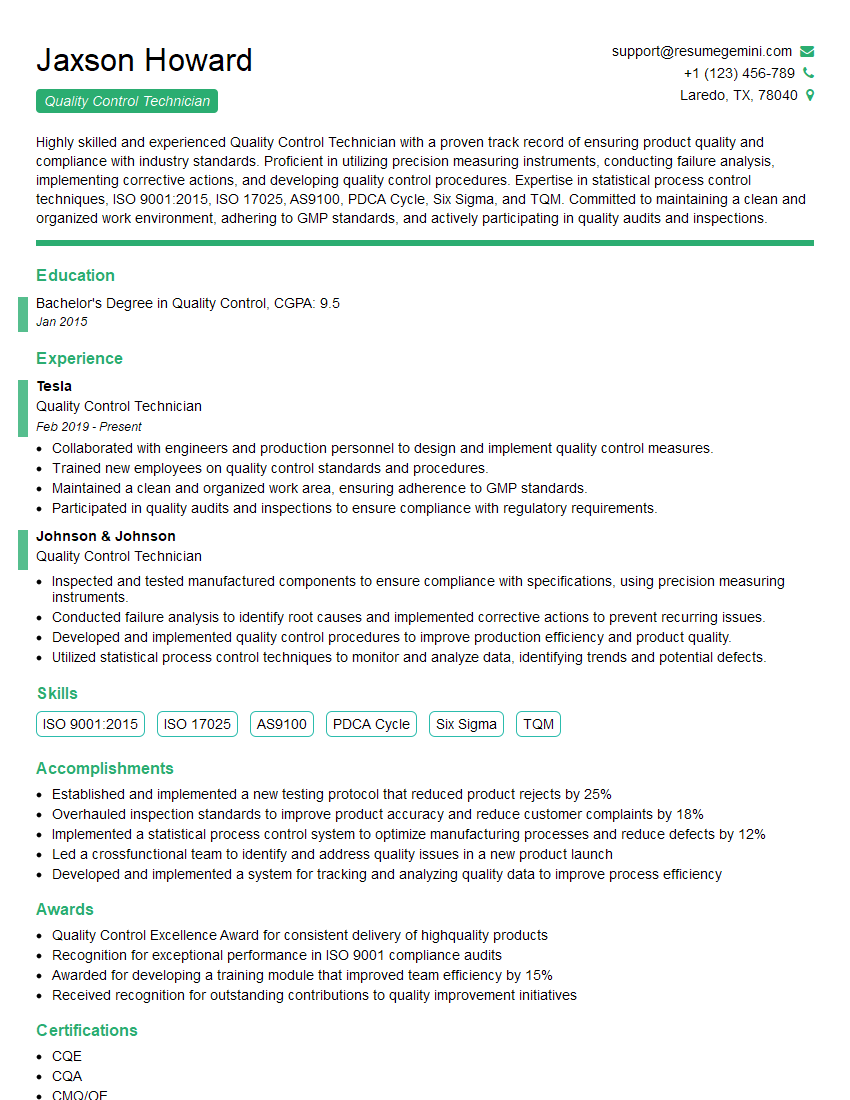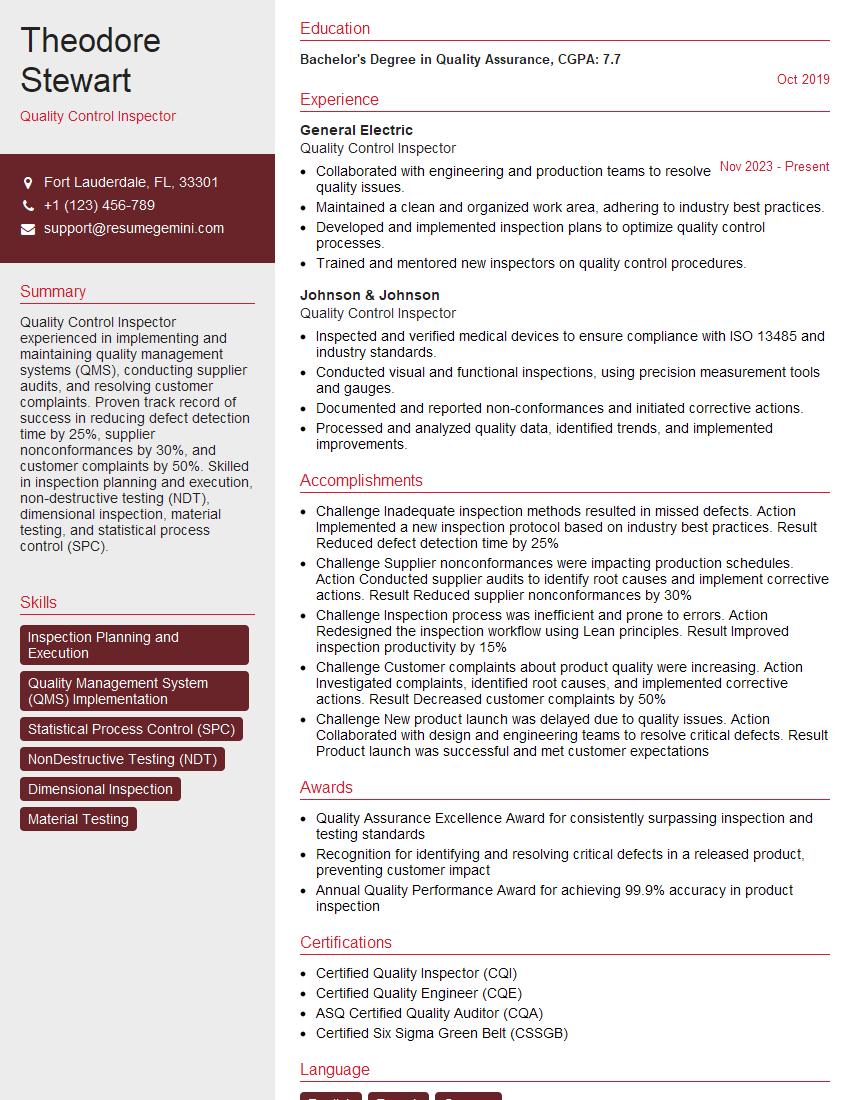Preparation is the key to success in any interview. In this post, we’ll explore crucial Project Management for Quality Control interview questions and equip you with strategies to craft impactful answers. Whether you’re a beginner or a pro, these tips will elevate your preparation.
Questions Asked in Project Management for Quality Control Interview
Q 1. Describe your experience implementing a quality management system (QMS).
Implementing a Quality Management System (QMS) involves a structured approach to consistently meeting customer and regulatory requirements. It’s like building a house – you wouldn’t just start laying bricks; you’d need blueprints (documented processes), skilled workers (trained personnel), and regular inspections (audits) to ensure the final product is sound and meets specifications.
In my experience, I’ve led the implementation of QMS in several projects, leveraging methodologies like ISO 9001. This involved:
- Gap Analysis: Identifying the current state of quality processes and comparing them to the desired QMS standards (e.g., ISO 9001). This helps pinpoint areas needing improvement.
- Process Mapping and Documentation: Creating detailed flowcharts and written procedures for all critical processes to ensure everyone understands their roles and responsibilities. This also aids in identifying potential bottlenecks.
- Training and Awareness: Providing comprehensive training to all team members on the QMS procedures and their importance in achieving project goals. This includes explaining the ‘why’ behind the processes, not just the ‘how’.
- Internal Audits and Management Review: Conducting regular internal audits to assess the effectiveness of the implemented QMS and identify areas for improvement. Management reviews ensure alignment with strategic objectives and resource allocation.
- Continuous Improvement: Implementing a system for continuous monitoring, measurement, analysis, and improvement (DMAIC or PDCA cycles) to ensure the QMS adapts to changing project needs and technological advancements.
For example, in a software development project, implementing a QMS meant establishing clear coding standards, rigorous testing protocols (unit, integration, system), and a robust defect tracking system. This significantly reduced the number of bugs in the final product and improved customer satisfaction.
Q 2. Explain your approach to risk assessment in quality control projects.
Risk assessment in quality control is crucial for proactive problem-solving. It’s like a pre-flight check for an airplane – you wouldn’t take off without ensuring everything is functioning correctly. My approach involves a systematic process:
- Identify Potential Risks: This involves brainstorming potential issues that could affect product quality, using techniques like brainstorming, checklists, and Failure Mode and Effects Analysis (FMEA). This could include things like supplier delays, equipment malfunction, or inadequate training.
- Analyze Risk Probability and Impact: For each identified risk, I assess the likelihood of it occurring and the severity of its impact if it does. A risk matrix is helpful here, visually representing the combination of probability and impact.
- Develop Risk Mitigation Strategies: Once risks are identified and analyzed, I develop strategies to reduce their probability and/or impact. This might involve contingency planning, implementing additional quality checks, or investing in better equipment.
- Monitor and Review: Throughout the project, I continuously monitor the identified risks and their mitigation strategies. The risk assessment should be a living document, updated as new information becomes available.
For example, in a construction project, a potential risk might be inclement weather delaying the project. Mitigation strategies could include purchasing weather insurance, adjusting the project schedule to accommodate potential delays, or using weather-resistant materials.
Q 3. How do you ensure effective communication within a quality control team?
Effective communication is the lifeblood of any successful quality control team. Think of it as the nervous system of the body – without it, different parts cannot function in harmony. My approach focuses on:
- Clear and Concise Communication: I ensure all communication, whether verbal or written, is clear, concise, and unambiguous. This minimizes misunderstandings and ensures everyone is on the same page.
- Regular Team Meetings: Holding regular team meetings to discuss progress, challenges, and potential risks. These meetings provide opportunities for open communication and problem-solving.
- Utilizing appropriate Communication Tools: Using various communication tools depending on the audience and context. This could include email, instant messaging, project management software, or even face-to-face meetings.
- Documentation and Reporting: Maintaining clear and accurate documentation of all communication and project decisions. This creates a transparent audit trail and ensures consistency.
- Active Listening: Practicing active listening during team meetings and one-on-one conversations to fully understand concerns and perspectives.
For example, using a project management software like Jira allows for centralizing communication, tracking progress, and assigning tasks transparently to all team members.
Q 4. What metrics do you use to track project quality and progress?
Tracking project quality and progress requires a multifaceted approach using key metrics. Think of it like monitoring a patient’s vital signs – you need to track multiple indicators to get a complete picture of their health. The metrics I use include:
- Defect Rate: The number of defects found per unit of output. A lower defect rate indicates better quality.
- Defect Density: The number of defects per 1000 lines of code (in software development) or per square meter (in construction), providing a standardized measure across different projects.
- Customer Satisfaction: Measuring customer satisfaction through surveys, feedback forms, and reviews. This provides valuable insight into the perceived quality of the final product.
- On-time Delivery Rate: Tracking the percentage of deliverables completed on schedule. This metric measures project efficiency and adherence to deadlines.
- Cost of Quality (COQ): Calculating the total cost associated with preventing, detecting, and correcting defects. This metric helps identify areas where resources can be optimized.
These metrics are regularly reported and reviewed to ensure we stay on track and identify areas requiring attention. Dashboards and reports help to visualize progress and identify trends.
Q 5. Describe a time you identified a critical quality issue. What was your approach to resolution?
In a previous project involving the development of a mobile application, we identified a critical performance issue during user acceptance testing (UAT). The app was extremely slow, rendering it unusable for many users. My approach to resolution involved:
- Root Cause Analysis: We used techniques like fishbone diagrams to identify the root cause of the performance issue. We discovered a poorly optimized database query that was significantly impacting response times.
- Develop a Solution: Based on the root cause analysis, we developed a solution involving database optimization and code refactoring to improve query efficiency.
- Testing and Verification: We rigorously tested the revised code to ensure the performance issue was resolved and did not introduce new problems. This involved performance testing and user acceptance testing.
- Communication and Transparency: We kept stakeholders informed throughout the process, explaining the issue, the solution, and the timeline for resolution. This maintained trust and prevented unnecessary anxiety.
- Post-Incident Review: After resolving the issue, we conducted a post-incident review to learn from the experience and improve our processes. This included refining our testing strategy to catch such issues earlier in the development lifecycle.
This experience highlighted the importance of robust testing, clear communication, and a proactive approach to problem-solving in quality control.
Q 6. How familiar are you with ISO 9001 standards?
I am very familiar with ISO 9001 standards. ISO 9001 is the internationally recognized standard for quality management systems. It provides a framework for organizations to establish, implement, maintain, and continually improve their QMS. I understand the requirements for documentation, internal audits, management review, and continuous improvement. I have used ISO 9001 principles as a foundation for implementing QMS in numerous projects, ensuring compliance and promoting a culture of quality.
My understanding extends beyond simply adhering to the standards; I understand how to leverage its principles to enhance efficiency and effectiveness within a project, even without formal certification.
Q 7. What quality control tools and techniques are you proficient in (e.g., Six Sigma, SPC)?
I am proficient in a range of quality control tools and techniques, including:
- Six Sigma: I’ve used DMAIC (Define, Measure, Analyze, Improve, Control) and DMADV (Define, Measure, Analyze, Design, Verify) methodologies to improve processes and reduce defects. I understand the use of statistical tools like control charts and process capability analysis.
- Statistical Process Control (SPC): I’m skilled in using control charts (e.g., X-bar and R charts, p-charts, c-charts) to monitor process stability and identify potential sources of variation. This allows for timely intervention to prevent defects.
- Failure Mode and Effects Analysis (FMEA): I use FMEA to proactively identify potential failure modes in a process or product and assess their potential impact. This helps prioritize risk mitigation efforts.
- Checklists and Inspection techniques: These are fundamental tools for ensuring consistency and adherence to standards throughout the project. I customize checklists based on specific project requirements.
- Root Cause Analysis (RCA) techniques: such as the 5 Whys and Fishbone diagrams, are regularly used to delve into the underlying causes of defects or problems, enabling effective solutions.
The specific tools and techniques I utilize depend on the nature of the project and the types of quality issues being addressed. My focus is on selecting the most appropriate methods to achieve the best outcomes.
Q 8. How do you handle conflicts between project timelines and quality standards?
Balancing project timelines and quality standards is a constant tightrope walk in project management. It’s not about choosing one over the other; it’s about finding the optimal balance. This often involves prioritization and proactive risk management.
My approach starts with clearly defining the quality standards upfront, aligning them with project goals and stakeholder expectations. We then conduct a thorough risk assessment, identifying potential conflicts between speed and quality. For instance, cutting corners on testing to meet a deadline is a significant risk.
- Prioritization: We use techniques like MoSCoW analysis (Must have, Should have, Could have, Won’t have) to prioritize features and tasks. Critical quality aspects are prioritized even if it means adjusting the timeline slightly.
- Negotiation: Open communication with stakeholders is key. If a deadline is inflexible, we collaboratively explore options to streamline processes, reduce scope, or augment resources to maintain quality.
- Contingency Planning: We build buffer time into the schedule for unexpected issues and quality control checks. This allows for flexibility without compromising the final product’s quality.
For example, in a recent software development project, we faced a tight deadline. By utilizing agile methodologies and prioritizing critical features, we delivered a high-quality minimum viable product (MVP) on time, while deferring less critical features to the next iteration.
Q 9. Explain your experience with root cause analysis techniques.
Root cause analysis (RCA) is crucial for preventing recurring quality issues. I’m proficient in several techniques, including the ‘5 Whys,’ fishbone diagrams (Ishikawa diagrams), and fault tree analysis.
The ‘5 Whys’ is a simple yet effective method where you repeatedly ask ‘why’ to uncover the underlying causes of a problem. For example, if a product fails, we might ask: Why did it fail? (Answer: faulty component). Why was the faulty component used? (Answer: inadequate supplier quality control). And so on, until the root cause is identified.
Fishbone diagrams provide a visual representation of potential causes categorized by factors like materials, methods, manpower, and machinery. This helps brainstorm comprehensively and identify contributing factors that might be missed with simpler methods.
Fault tree analysis is more complex and suited for critical situations. It uses a top-down approach, starting with the undesired event and working backward to identify potential causes and their probabilities. This allows for a quantitative assessment of risk.
In a previous project involving manufacturing defects, we used a combination of the ‘5 Whys’ and a fishbone diagram to pinpoint the root cause of inconsistencies in product dimensions, ultimately tracing it to a malfunctioning machine component.
Q 10. How do you ensure quality control processes are integrated throughout the project lifecycle?
Quality control isn’t a separate phase; it’s woven into every stage of the project lifecycle. This is achieved through proactive planning, continuous monitoring, and iterative improvements.
- Planning Phase: Quality standards and metrics are defined early on, along with a detailed quality control plan. This includes specifying inspection criteria, acceptance standards, and reporting mechanisms.
- Execution Phase: Regular inspections and testing are conducted to monitor progress and identify deviations early. This often involves using checklists, statistical process control (SPC) charts, and other quality management tools.
- Closure Phase: A final quality audit ensures the project deliverables meet the pre-defined standards. Lessons learned are documented to improve future projects.
Think of it like building a house: You wouldn’t wait until the end to check the foundation’s strength. Quality checks happen at each stage—laying the foundation, framing the walls, installing the plumbing, etc.
Q 11. Describe your experience with quality audits and inspections.
I have extensive experience conducting both quality audits and inspections. Audits are comprehensive assessments of the overall quality management system, while inspections focus on specific aspects of a project or product.
Quality Audits: I have led numerous audits, using checklists and documented procedures to evaluate compliance with standards, identify areas for improvement, and verify the effectiveness of quality control processes. My audits incorporate both compliance checks (are we following procedures?) and effectiveness checks (are the procedures achieving the desired outcome?).
Inspections: Inspections are more targeted and often involve visual examination, measurements, and testing to verify that specific deliverables meet the specified requirements. I use various inspection techniques, including visual inspection, dimensional checks, and functional testing, depending on the nature of the project.
For example, in a construction project, we conducted regular inspections to ensure compliance with building codes, while a separate audit assessed the overall project management system’s effectiveness. In both cases, detailed reports were produced with findings, recommendations, and corrective actions.
Q 12. How do you measure the effectiveness of your quality control processes?
Measuring the effectiveness of quality control processes is vital to ensure continuous improvement. We use several key performance indicators (KPIs) to track our progress and identify areas requiring attention.
- Defect Rate: The number of defects found per unit of work. A decreasing defect rate indicates improvement.
- Cost of Quality: This encompasses the cost of prevention, appraisal, internal failure, and external failure. Minimizing this cost shows an effective quality system.
- Customer Satisfaction: Feedback surveys and reviews provide insights into customer perception of quality.
- Process Capability Indices (Cp, Cpk): These statistical measures assess the ability of a process to meet specifications.
By regularly monitoring these KPIs, we can identify trends, pinpoint problems early, and take corrective actions to maintain high quality. For instance, if the defect rate suddenly increases, it triggers an investigation to understand the cause and implement appropriate solutions.
Q 13. How do you manage and mitigate quality risks in a project?
Proactive quality risk management is essential to avoid costly rework and delays. My approach involves identifying, analyzing, assessing, and mitigating potential quality risks throughout the project lifecycle.
- Risk Identification: We use brainstorming, checklists, and past project experience to identify potential quality risks. This includes risks related to materials, processes, personnel, and external factors.
- Risk Analysis: Each risk is analyzed using qualitative and quantitative methods to assess its likelihood and potential impact on quality.
- Risk Response Planning: Strategies are developed to mitigate the identified risks. These might include avoiding the risk, transferring the risk, mitigating the risk, or accepting the risk.
- Risk Monitoring and Control: The risks are continuously monitored and controlled throughout the project, with contingency plans in place to address unexpected issues.
In one project, we identified the risk of supply chain disruptions. To mitigate this, we developed a contingency plan that included sourcing from multiple suppliers and establishing buffer inventory. This helped ensure consistent material supply and prevent project delays.
Q 14. What is your experience with corrective and preventive actions (CAPA)?
Corrective and Preventive Actions (CAPA) is a systematic approach to address quality issues and prevent their recurrence. This involves identifying the root cause, implementing corrective actions to fix the immediate problem, and implementing preventive actions to prevent similar problems in the future.
My experience with CAPA includes developing and implementing CAPA plans, conducting root cause analyses, and tracking the effectiveness of implemented actions. I utilize a structured process that typically includes:
- Problem Reporting: Documenting the problem clearly and concisely.
- Root Cause Analysis: Using appropriate techniques (e.g., 5 Whys, fishbone diagrams) to determine the root cause.
- Corrective Action: Implementing immediate actions to resolve the current problem.
- Preventive Action: Implementing actions to prevent the problem from recurring.
- Verification and Validation: Confirming that corrective and preventive actions are effective.
- Follow-up: Monitoring the effectiveness of the implemented actions over time.
In a previous project, a recurring software bug was identified. Through a CAPA process, we identified a coding error as the root cause, implemented a code fix (corrective action), and introduced stricter code review procedures (preventive action). This effectively resolved the issue and prevented similar bugs in future releases.
Q 15. How do you utilize data analysis to improve quality control processes?
Data analysis is crucial for proactive quality control. Instead of simply reacting to problems, we can use data to predict and prevent them. This involves collecting data from various sources – defect tracking systems, customer feedback surveys, testing results, and even from project management software itself.
For example, let’s say we’re developing software. I would analyze defect data to identify trends. Are certain modules consistently producing more bugs? Are specific types of defects more prevalent? This analysis might reveal a need for more rigorous testing in a particular area, or it could point to a deficiency in the design or coding process. This data-driven approach allows for targeted interventions, leading to significant improvements in quality.
Another example: If we’re manufacturing a product, I’d use statistical process control (SPC) charts to monitor key metrics such as defect rates or dimensions. These charts visually display data over time, highlighting patterns and anomalies. A sudden spike in defects, for instance, would trigger an immediate investigation to find the root cause and prevent further issues.
Ultimately, data analysis empowers me to make informed decisions, optimize processes, and improve overall product or project quality, resulting in cost savings and increased customer satisfaction.
Career Expert Tips:
- Ace those interviews! Prepare effectively by reviewing the Top 50 Most Common Interview Questions on ResumeGemini.
- Navigate your job search with confidence! Explore a wide range of Career Tips on ResumeGemini. Learn about common challenges and recommendations to overcome them.
- Craft the perfect resume! Master the Art of Resume Writing with ResumeGemini’s guide. Showcase your unique qualifications and achievements effectively.
- Don’t miss out on holiday savings! Build your dream resume with ResumeGemini’s ATS optimized templates.
Q 16. Explain your experience with quality control documentation and reporting.
Thorough documentation and reporting are fundamental to effective quality control. I’ve consistently utilized various methods to ensure transparency and traceability throughout projects. This includes maintaining detailed records of all quality control activities, such as inspection reports, test plans, and deviation reports. These documents serve as an audit trail, enabling us to track progress, identify areas for improvement, and resolve issues efficiently.
My reports typically include key performance indicators (KPIs) such as defect rates, rework costs, and customer satisfaction scores. These KPIs provide a quantitative assessment of our quality performance and are vital for making data-driven decisions. I always tailor my reporting style to the audience; a high-level summary for senior management, while a more detailed report might be suitable for the project team. I leverage various tools, including spreadsheets and project management software, to create visually appealing and informative reports.
For instance, in a previous project, I implemented a system for tracking and reporting customer feedback. This allowed us to quickly identify and address recurring issues, improving both product quality and customer satisfaction.
Q 17. How do you train and mentor team members in quality control best practices?
Training and mentoring are critical for building a strong quality control culture within a team. My approach focuses on both practical skills and theoretical understanding. I start by clearly explaining quality control principles and best practices, using real-world examples to illustrate key concepts. This often involves interactive workshops or training sessions where team members actively participate in activities such as root cause analysis and defect prevention strategies.
Mentoring goes beyond simply delivering information; it’s about providing individual guidance and support. I work closely with each team member, tailoring my approach to their specific needs and experience levels. I encourage them to ask questions, share challenges, and learn from their mistakes. Regular feedback sessions allow me to track their progress, offer constructive criticism, and ensure they’re effectively applying quality control principles in their daily tasks. I also encourage collaboration and knowledge-sharing within the team through peer reviews and mentoring sessions. I find that a collaborative approach fosters a strong sense of ownership and accountability.
One example: I created a ‘Quality Champion’ program where experienced team members mentor newer colleagues, further strengthening the knowledge base and promoting a supportive environment.
Q 18. Describe a situation where you had to negotiate quality requirements with stakeholders.
Negotiating quality requirements is often a delicate balancing act. It requires strong communication, technical expertise, and an understanding of stakeholder priorities. In one project, a client initially requested extremely stringent quality requirements that would have significantly increased development time and cost.
To address this, I first thoroughly documented all requirements, analyzing their feasibility and impact on the project timeline and budget. I then prepared a detailed presentation outlining various options, each with its respective costs and benefits. This included outlining the risks associated with relaxing certain requirements. During the negotiation, I focused on active listening and collaboration, seeking to understand the client’s underlying concerns and priorities. We ultimately reached a compromise that involved prioritizing critical requirements while scaling back on some less crucial ones, without compromising overall product quality.
This negotiation resulted in a project that met the client’s key needs while remaining within budget and on schedule. The key was clear and open communication, a collaborative approach, and a thorough understanding of both the technical aspects and the client’s business goals.
Q 19. How do you prioritize competing quality control tasks?
Prioritizing competing quality control tasks requires a structured approach. I typically use a risk-based prioritization framework. This means that tasks are ranked based on their potential impact on project success and the likelihood of occurrence. For example, a high-risk, high-impact task, like testing a critical system component, would be prioritized over a low-risk, low-impact task, like reviewing a minor documentation update.
I often use a matrix to visualize this prioritization, assigning scores based on risk and impact. This matrix allows me to quickly identify and focus on the most critical tasks. I also consider the dependencies between tasks, ensuring that critical prerequisites are addressed before proceeding to dependent activities. Finally, resource allocation is also a critical factor. I ensure that the team has the necessary resources and expertise to address the highest priority tasks effectively. This might involve adjusting schedules or requesting additional support, if needed.
Q 20. How do you maintain consistent quality across geographically dispersed teams?
Maintaining consistent quality across geographically dispersed teams requires a robust and well-defined quality management system. This involves establishing clear communication channels, standardized processes, and shared tools and resources.
I use a combination of strategies, such as establishing a centralized quality management system (using project management software or a shared document repository), consistent training programs for all teams, regular virtual meetings for knowledge-sharing and issue resolution, and frequent quality audits of each team’s output. It is important to establish clear roles and responsibilities for quality control within each team and across the organization. Utilizing collaborative project management tools allows everyone to stay informed and updated on progress, changes, and issues.
Furthermore, employing standardized templates for documentation, reporting, and testing procedures ensures consistency across all locations. Regular communication and feedback loops are crucial to identify and address deviations quickly. Ultimately, building trust and fostering a strong sense of team cohesion, even across distances, is vital to success.
Q 21. Describe your experience using project management software for quality control.
I have extensive experience using project management software for quality control. Tools like Jira, Asana, and MS Project are invaluable for managing and tracking quality-related tasks, defects, and risks. I use these platforms to create and manage test plans, track test results, and document defects. This allows for centralized tracking of quality metrics and efficient collaboration among team members.
For instance, in Jira, I can configure workflows to manage the lifecycle of a defect, from its initial identification to its resolution and verification. Custom fields can be created to track specific quality attributes or metrics relevant to the project. Reporting dashboards in these tools provide real-time insights into the overall quality status, enabling proactive identification of potential issues. The ability to integrate with other tools, such as test management systems, further enhances efficiency and streamlines the quality control process. The use of these tools also allows for transparent communication and collaboration, improving team cohesion and knowledge sharing.
Q 22. What are the key differences between Quality Assurance and Quality Control?
Quality Assurance (QA) and Quality Control (QC) are often confused, but they represent distinct yet complementary aspects of ensuring quality. Think of QA as prevention and QC as detection.
Quality Assurance (QA): Focuses on preventing defects by establishing processes, procedures, and standards. It’s proactive and aims to build quality into the project from the outset. Examples include defining clear requirements, implementing robust testing strategies before the product is built, and regularly auditing processes for effectiveness.
Quality Control (QC): Focuses on detecting defects after the product or process has been completed. It’s reactive and aims to identify and correct errors to meet established quality standards. Examples include conducting inspections, testing individual components or the final product, and performing audits to check compliance with specifications.
In short: QA is about doing the right things, while QC is about doing things right.
Q 23. How do you handle situations where quality control measures are not met?
When quality control measures aren’t met, a structured approach is crucial. My process involves:
Identify and document the non-conformance: Clearly define the deviation from the established standards, including the nature, extent, and location of the problem. Detailed documentation is essential for traceability and analysis.
Investigate the root cause: This step is critical. Use techniques like the ‘5 Whys’ or Fishbone diagrams to uncover the underlying causes of the non-conformance. Was it a process flaw, a lack of training, or a material defect?
Implement corrective actions: Based on the root cause analysis, develop and implement corrective actions to prevent recurrence. This might involve retraining staff, revising processes, or improving materials.
Verify effectiveness: After implementing the corrective actions, verify their effectiveness through further testing or inspections to ensure the problem has been resolved and won’t reoccur.
Document everything: Maintain a comprehensive record of the non-conformance, the investigation, corrective actions, and verification. This forms the basis for continuous improvement.
For instance, if a software module fails a unit test, I’d investigate the code, fix the bug, re-run the test, and document the entire process.
Q 24. How do you balance the cost of quality control with project budgets?
Balancing the cost of quality control with project budgets is a delicate act of prioritization. It’s not about minimizing QC costs, but about optimizing them for maximum impact. I approach this by:
Risk-based approach: Prioritize quality control efforts on areas with the highest potential risk or impact. For example, a critical system component will receive more rigorous testing than a less crucial feature.
Cost-benefit analysis: Evaluate the cost of implementing different QC measures against the potential cost of defects escaping to the customer. Preventing a major defect late in the project is far more expensive than early detection.
Automation: Utilize automation wherever possible to reduce the manual effort involved in testing and inspection. Automated testing can significantly reduce costs and increase efficiency.
Process optimization: Streamlining processes can reduce waste and improve efficiency, thereby reducing the overall cost of quality control. Identifying and eliminating bottlenecks in workflow helps achieve both efficiency and cost savings.
For example, instead of manually inspecting every component, we might implement statistical sampling to reduce the inspection load while maintaining a high level of confidence in quality.
Q 25. How familiar are you with different types of quality control charts?
I’m very familiar with various quality control charts, including:
Control Charts: These charts are used to monitor process variation over time. Examples include the Shewhart chart (X-bar and R charts), which track the mean and range of a process, and the CUSUM chart, which is particularly sensitive to small shifts in the process mean.
Pareto Charts: Used to identify the ‘vital few’ causes contributing to the majority of problems. They visually rank causes by their frequency of occurrence, helping prioritize improvement efforts.
Histograms: Used to visually represent the frequency distribution of a data set. They provide insights into the shape of the data and can help identify outliers or potential process issues.
Scatter Diagrams: Show the relationship between two variables. Useful for identifying potential correlations and investigating potential root causes.
The choice of chart depends on the specific data being analyzed and the objective of the analysis. For example, I’d use a control chart to monitor the weight of a product during manufacturing and a Pareto chart to investigate the causes of customer complaints.
Q 26. What are your preferred methods for tracking and managing non-conformances?
My preferred method for tracking and managing non-conformances is a combination of a centralized database and a workflow management system. The database tracks the details of each non-conformance (description, severity, location, assigned personnel, etc.), while the workflow system manages the investigation, corrective action, and verification steps.
Specific tools could include a dedicated defect tracking system (like Jira or Bugzilla), a project management software with built-in issue tracking (like Asana or Trello), or even a customized spreadsheet if the project is small. The key is to have a system that allows for clear documentation, efficient workflow management, and easy reporting and analysis.
Additionally, regular reporting and review meetings are essential to monitor the effectiveness of the non-conformance management process and identify any systemic issues that need attention.
Q 27. How do you ensure continuous improvement in your quality control processes?
Continuous improvement in quality control is achieved through a structured approach using tools like the PDCA (Plan-Do-Check-Act) cycle.
Plan: Identify areas for improvement based on data analysis, customer feedback, and process audits.
Do: Implement changes to improve the process.
Check: Monitor the results of the changes to assess their effectiveness.
Act: Standardize effective changes and identify further areas for improvement.
Regular review meetings, data analysis, and employee feedback are essential for identifying opportunities for improvement. For example, reviewing QC data might reveal a recurring issue with a specific manufacturing process, prompting a review and improvement of that process.
Also, adopting a culture of continuous improvement within the team is key. Encouraging employees to identify and report problems, suggest solutions, and participate in improvement initiatives fosters a proactive approach to quality.
Q 28. Describe a time you had to make a difficult decision regarding quality vs. schedule.
In a previous project developing a medical device, we encountered a situation where a critical software component failed testing just a week before the planned launch. The fix would require significant rework and could potentially delay the launch.
The decision was difficult: compromising quality could have serious consequences, while delaying the launch would incur significant financial penalties and potentially impact patient care.
After careful consideration, we opted to delay the launch by two weeks to allow for thorough testing and verification of the fix. This involved intense collaboration with all stakeholders, clear communication to affected parties, and meticulous management of the rework process. While this impacted the schedule, ultimately, prioritizing quality ensured patient safety and maintained the integrity of the product, protecting the long-term reputation of the company.
This experience highlighted the importance of risk assessment and open communication when faced with such trade-offs. While schedule pressure is always present, jeopardizing quality can have far more serious repercussions than a minor delay.
Key Topics to Learn for Project Management for Quality Control Interview
- Quality Management Systems (QMS): Understanding ISO 9001, Six Sigma, or other relevant frameworks and their practical implementation in project settings.
- Risk Management in Quality Control: Identifying, assessing, and mitigating potential risks that could impact project quality. This includes proactive measures and contingency planning.
- Quality Control Tools and Techniques: Proficiency in using tools like Pareto charts, control charts, fishbone diagrams, and other statistical process control methods for data analysis and problem solving.
- Quality Assurance Processes: Developing and implementing processes to ensure consistent quality throughout the project lifecycle, from planning to closure.
- Metrics and Reporting: Defining and tracking key performance indicators (KPIs) related to quality, generating reports to monitor progress and identify areas for improvement.
- Root Cause Analysis (RCA): Mastering techniques to identify the underlying causes of quality defects and implementing corrective actions to prevent recurrence.
- Continuous Improvement Methodologies: Understanding and applying methodologies like Kaizen or Lean principles to enhance quality control processes over time.
- Communication and Collaboration: Effective communication with stakeholders at all levels to ensure alignment on quality expectations and reporting on progress.
- Project Planning and Scheduling: Integrating quality control activities into the overall project plan, ensuring sufficient time and resources are allocated.
- Auditing and Inspections: Conducting internal and external audits to verify compliance with quality standards and identify areas needing attention.
Next Steps
Mastering Project Management for Quality Control significantly enhances your career prospects, opening doors to leadership roles and higher earning potential. A well-crafted resume is crucial for showcasing your skills and experience to potential employers. Building an ATS-friendly resume is vital for ensuring your application gets noticed. To help you create a compelling and effective resume, we recommend using ResumeGemini, a trusted resource for building professional resumes. Examples of resumes tailored to Project Management for Quality Control are available to guide you through the process.
Explore more articles
Users Rating of Our Blogs
Share Your Experience
We value your feedback! Please rate our content and share your thoughts (optional).
What Readers Say About Our Blog
There are no reviews yet. Be the first one to write one.
